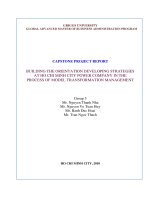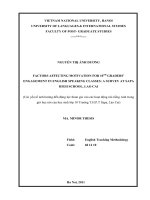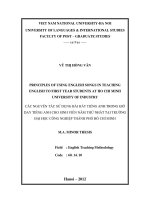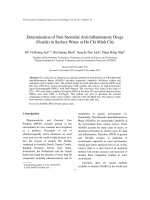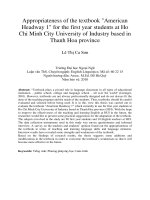Solution for low employee engagement in military joint stock bank survey at ho chi minh city branch
Bạn đang xem bản rút gọn của tài liệu. Xem và tải ngay bản đầy đủ của tài liệu tại đây (623.1 KB, 66 trang )
UNIVERSITY OF ECONOMICS HO CHI MINH CITY
International School of Business
------------------------------
HUYNH MINH TRANG
SOLUTION FOR LOW EMPLOYEE
ENGAGEMENT IN MILITARY JOINT- STOCK
BANK – SURVEY AT HO CHI MINH CITY BRANCH
MASTER OF BUSINESS ADMINISTRATION
Ho Chi Minh City – Year 2016
1
UNIVERSITY OF ECONOMICS HO CHI MINH CITY
International School of Business
------------------------------
HUYNH MINH TRANG
SOLUTION FOR LOW EMPLOYEE
ENGAGEMENT IN MILITARY JOINT- STOCK
BANK – SURVEY AT HO CHI MINH CITY BRANCH
ID: 22130080
MASTER OF BUSINESS ADMINISTRATION
SUPERVISOR: DR. NGUYEN PHONG NGUYEN
Ho Chi Minh City – Year 2016
2
TABLE OF CONTENTS
EXECUTIVE SUMMARY ............................................................................................................................... 6
CHAPTER 1: PROBLEM DEFINITION ......................................................................................................... 7
1.1
Background of problem ......................................................................................................................... 7
1.2 Problem and situation analysis .................................................................................................................. 12
1. 2.1. Problem definition: ....................................................................................................................... 12
1.2.2. Justify the existence: ...................................................................................................................... 13
1.2.3. Justify the importance of the chosen problem: .............................................................................. 15
Job performance: ............................................................................................................................................. 15
Job satisfaction: ............................................................................................................................................... 16
High intention turnover: .................................................................................................................................. 17
CHAPTER 2: CAUSE VALIDATION ........................................................................................................... 18
2.1
. Potential causes: ................................................................................................................................ 18
Job characteristic ..................................................................................................................................... 19
Supervisory relations/support .................................................................................................................. 19
Co-worker relations ................................................................................................................................. 20
Perceived organizational support: ........................................................................................................... 20
Training and career development: ........................................................................................................... 20
Reward and recognition:.......................................................................................................................... 21
Distributive and procedural justice: ......................................................................................................... 21
2.2
. Causes justification ............................................................................................................................ 24
Supervisor support: .................................................................................................................................. 26
Training and career development ............................................................................................................ 27
Rewarding and recognition:..................................................................................................................... 27
Distributive and procedure justice: .......................................................................................................... 28
CHAPTER 3: SOLUTION .............................................................................................................................. 30
3.1. Potential alternative solution and solution analysis: ................................................................................. 30
Reward and recognition ........................................................................................................................... 30
Supervisor relation and support: .............................................................................................................. 32
Training and career development: ........................................................................................................... 33
3
Distributive and procedure justice: .......................................................................................................... 34
3.2 Comparison and analysis possible solution: .............................................................................................. 35
3.3. Action plan ............................................................................................................................................... 36
3.4 Testing design requirement ....................................................................................................................... 38
CHAPTER 4: CONCLUSION ........................................................................................................................ 39
CHAPTER 5: SUPPORTING INFORMATION ............................................................................................ 40
5.1.
Scale items and questionnaires: ........................................................................................................... 40
5.2.
Survey of level of employee engagement results ................................................................................ 46
5.3.
List of participation interview and representative transcription .......................................................... 46
5.3.1.
List of participants ................................................................................................................... 46
5.3.2.
Representative transcription .................................................................................................... 47
LIST OF REFERENCES ................................................................................................................................ 65
4
LIST OF FIGURE
Figure 1.1: Problem mess at MB .................................................................................................................... 10
Figure 2.1: Initial cause-effect-map................................................................................................................ 24
LIST OF TABLES
Table 2.1: Potential cause and scale items ...................................................................................................... 22
Table 3.2: Summarize causes and solution ...................................................................................................... 35
Table 3.3: Action plan ..................................................................................................................................... 37
Table 3.4: Design requirement ........................................................................................................................ 38
Table 5.2: Level of employee engagement result ............................................................................................ 46
Table 5.3: List of participants .......................................................................................................................... 46
5
SOLUTION FOR LOW EMPLOYEE ENGAGEMENT IN MILITARY JOINTSTOCK BANK – SURVEY AT HO CHI MINH CITY BRANCH
EXECUTIVE SUMMARY
The recent year was a difficulties and challenges year for the whole banking industry. With
the slow credit growth, high competition and other problems in banking system, banks have
to face with many huge concerned issues. In this situation, the target of every bank is
achieving the significant operating results, which can be seen clearly as the bank
profitability, and maintaining good traditional customers. This research is taken place at
Military Joint Stock Bank – Ho Chi Minh City branch with three purposes. Finding the main
problem the bank are facing in recent years, the important antecedents of the problem and
the way to solve that problem. After a whole investigated process, low employee
engagement is considered as the main problem at MB. Supervisor relation, training, and
career development, reward and recognition, distributive and procedure justice are the main
causes of the low employee engagement at MB. For the action plan, restructuring payment
system, updating training program, establishing clear assessment and outdoor activities are
held to enhance the level of engagement at MB.
6
CHAPTER 1: PROBLEM DEFINITION
1.1 Background of problem
Military Joint Stock Bank is one of the top five largest Commercial Joint Stock Bank in Viet
Nam. It was established in 1994 with the charter capital of twenty billion Vietnam Dong and
twenty-five employees. The purpose of MB is providing financial support to Military
enterprises. From 1994 to 2014, MB has created a typical icon in Banking and financial
market of Vietnam with the business target was achieved at a high level. Ho Chi Minh City
Branch is the first branch of Military Bank (MB), which was established in 1996. MB is
going to celebrate 20 years establishing the first branch in the southern Area. Southern area
branches have contributed on the development and successful of MB. Forty per cent profit
of MB comes from this area. This study bases on the survey doing at Ho Chi Minh City
branch.
According to the report of MB Board Director, be attention of the high intention turnover,
the decreasing of productivity, decreasing the loyalty of traditional customer and difficult
for getting new customers are considered as the target of sustainable development. Among
these issues, the most important target of MB is maintaining and finding good financial
customers. The research of Ho Chi Minh City branch corporation office reveals that the
number of corporate customer in 2014 is 218 customers and in the first three month of 2015
are 176 customers. It indicates that the number of corporate customer decrease 19.2% and
tend to decrease in the next period. The report also indicates that the level of traditional
7
customers that terminate their cooperation with MB is increasing. Based on the result of
interviews there are three-importance problems for this issue.
The first issue is high competition. Ms. Thao, a subsidiary’s manager has shared that
although weak banks have already merged, however, the financial market still has other
banks with the strong financial support along with diversified products and high quality of
service. In addition, more and more foreigner banks are investing in Vietnam with high-tech
product and good service... These competitors have put MB in an emergency that need to
increase the quality of service, diversifying product or investing more in information
technology. Therefore, want to keep traditional customers and attract more customers, it is
necessary to beware of competitors.
Besides that, following the financial crisis, there were fluctuations in domestic and
international economies, the real estate and securities’ markets are quiet which impact on
banking. According to the message of Mr. Le Huu Duc, the chairperson of the board of
directors, the credit growth is low while the bad debt ratio increased sharply as a the result
of the weakening of corporate customers. Bank profit decline significantly and weak banks
have to be merged. In addition, the increasing of loan interest rate and the difficulty of
capital mobilization are cause the decreasing in bank profitability With the economic
situation, it is not only hard for getting good customers, but helping them to maintain their
business in a good mood is also a difficult responsibility.
The final problem relates to human resource: low employee engagement. Employee is the
principal resource of an organization; it helps organization achieves high outcomes and gets
8
company goals. Employee engagement refers to the interaction between employee and
organization. Through the interviews with employees and managers, some managers shared
that they were complained about working attitude of their employees, employees seem not
interested much in their job. Employees are easily distracted when working and have low
engagement with the organization. This issue leads to the low performance of employee.
Moreover, many employees said that the reward and recognition were not as they expected
they felt no enthusiasm for working and have low absorbed in work performance. As Ms
Thuy states that, these emotions relate to the low engagement, which is the reason of low
productivity of employee and low performance. Because of the low performance, it is
difficult for bank to keep customer’s loyalty.
Through the intake and orientation with MB, a problem mess can be drawn to describe the
present situation.
9
Difficulty for
capital
mobilization
Loan
interest rate
increase
Financial
crisis
Bad debt
ratio
increase
Credit
growth is
low
Foreigner
bank
Good
service
….
High
competition
Diversify
products
High tech
product
Unfair of decision
making procedure
Hard for
getting and
keeping
good
customer
High quality of
service
Low employee engagement
Do not have clearly
career development
Low of
recognition and
reward
Figure 1.1: Problem mess at MB
To summarize, in the recent years, MB is facing with three main problems: the low
engagement of employee, the high competition and the difficulty of the economy. While
high competition and difficulty of economy are the external problem that the entire banking
industry has to deal with, the low engagement is internal issue. The level of engagement is
difference for every bank base on the bank resource and characteristic. According to Mr. Le
Cong, the general director of MB has stated that, in future, MB will concentrate on human
10
resource. Focusing on Human Resource enhancement that is attached to “training, planning,
assessment, rewarding and cultural environment of MB has resulted in high productivity
and quality of the employee”. It is MB strategy for the next future. It is easy to attract
employee to participate in the organization but it is difficult to maintain employee working
attitude and engagement. Making a strong engagement of employee for retaining the
sustainable organization for customer is one of the targets of MB. Employee’s productivity
and quality are considered as an important key for the success of the organization.
In the annual report 2014 of the chairman of the board of director, it was emphasized that:
“MB continued to it restructure comprehensively and make many breakthroughs with
investments in information technology, and develop many services and products with hightech content, concentrate on developing MB brand that is community-oriented”, by that,
creating high competition ability for MB.
With the difficulty of economy problem, MB will combine the collective strength; create
momentum for the new period of development. Continuing to maintain restructuring and
sustainable development is also a necessary step in this current difficulty situation.
With the limit of time, organization budget and due to the main strategy of MB, which
focuses on enhancing the quality and employee productivity in the present period, this study
chooses employee, engagement is the central problem to be solved for improving the
productivity and quality of employee at MB.
11
1.2 Problem and situation analysis
1. 2.1. Problem definition:
According to Markos and Sridevi (2010) employee engagement is the predictor of positive
organizational performance. It shows the two-way relationship between employer and
employee. “Engaged employees are emotionally attached to their organization and highly
involved in their job with great enthusiasm for the success of their employer, going extra
mile beyond the employment contractual agreement” (Markos & Sridevi, 2010). Another
conceptualization of Kahn (1990) defined employee engagement as the expression of
organization member’s physically, cognitively, and emotionally during role performance.
Employee engagement can also be defined by W. B. Schaufeli et al. (2002, p.74) as “a
positive, fulfilling, work-related state of mind that is characterized by vigor, dedication, and
absorption”. It is the degree to which individual is attentive and absorbed in the
performance of their work (Saks, 2006). A study of C. Maslach, Schaufelli, and Leiter
(2001) argued that job engagement is associated with a sustainable workload, feeling of
choice and control, appropriate recognition and reward, meaningful and valuable work.
Employees who have high engagement come to work every day with a connection to their
organization, and enthusiasm for their work (Buckingham & Coffman, 1999) and the
outcome of it is a high level of performance. Engaged employee also has the positive effect
on customer-satisfaction rating scale (Vance, 2006) which will increase the loyalty of
customers. In addition, employees who have high engagement with their work are more
focus on organizational outcomes.
12
1.2.2. Justify the existence:
For measuring the level of engagement, interview and questionnaire method are used.
Employees and managers shared their opinions and emotions about their work through the
interview questions. Furthermore, there are also many interviews with customers, who have
been cooperated with MB for many years. In the survey, questionnaires are sent out for
employees at four banks in the top five for comparing the level of engagement.
Vietcombank, BIDV, Sacombank and MB are the chosen bank for this survey. The reasons
for comparing MB with Vietcombank, BIDV and Sacombank are that all of these banks
have the similar target which is becoming the biggest and the most profitable in Vietnamese
banking industry. The total asset, profit, or number of employee at these banks is similar
with each other. Moreover, all of three above bank are considered as the main competitor of
MB. Employees are chosen from different departments and positions of the branch in the
scope of District 11, Ho Chi Minh City. All the answers are kept secretly, the survey papers
are kept anonymous and only used for research purpose. Questions relate to the scale item
base on the questionnaire established by W. B. Schaufeli et al. (2002) for measuring the
level of vigor, dedication, and absorption, which are the characteristic of engagement.
Questionnaires are made up of 17 items, including six items of vigor scale, 5 items of
dedication scale and 6 items of absorption scale. All items were scored on the 7 point rating
scale ranging from 1 (not agree) to 7 (totally agree). Detail of the questionnaire can be seen
at chapter 5: Supporting information, section 5.1: Scale items and Questionnaires. 120
survey papers are sent out for employee at different departments of 4 branches in the chosen
bank. The number of respondent paper is 94. The average age of employee at banks is 30
13
with 88.7% having bachelor degree. With the Mean is 3.5, the level of engagement at each
bank is 5.5, 4.2, 3.9, 3.3 respectively. The level of employee engagement at MB is 3.3,
which is the lowest rate among four banks. (See table 5.1: Level of employee engagement
result for more detail). Employee usually distracted when performing work, and they do not
exert all their energy for working and usually avoid working overtime.
Besides questionnaire, personal interview is also a good method for employee to share their
feeling and emotion about job and the organizational engagement. Mr Son, a relationship
manager, shared that his working day starts at 7 am by listening many customer phone calls,
transferring from Customer Company to the bank and other departments several times for
getting documents, signing, and asking for supervisor’s opinion. In addition, the policy is
not stable; it is difficult for both of employee and customer to follow with the change of
bank policies. He is not satisfied with his current job and wants to change it when getting a
good one.
Ms Thuy, a supporting officer said that: “I have to work 12 hours a day! I cannot suffer for
this job anymore. I do not want to participate in any activity of the bank and do not have
enthusiasm for work. I am tired because of worrying about customer loans or nonperformance loan rate”. High workload is also one of the reasons that make her feel
exhausted. “In addition, the reward and recognition are not interesting; I have been working
5 years however, my salary is as same as the new comers” said by Ms Thuy.
Another sharing is from Ms Thu, a teller at MB, “It has changed too much since I have been
here four years ago. The requirement for my work is higher. We have to work overtime to
14
meet the expectation, but the salary is not good enough. Moreover, I am not interested in my
job anymore”.
It can be concluded that employees have negative feeling of working. Lacking employee’s
dedication for job is one of the big problems of employees. Besides that, employees do not
get satisfaction from their job, no enthusiastic for working and have a low level of employee
loyalty. The result from the questionnaire and interview shows that there is an existing
problem of MB in the recent years: Low employee engagement.
1.2.3. Justify the importance of the chosen problem:
Low engagement has an important influence on performance of employee as well as the
productivity of organization. Throughout a process of interview employee and literature
review, unless the low employee engagement is enhanced, the organization will face with
three big consequences as the low job performance, low employee satisfaction and high
intention turnover rate which impact directly on the organization profitability and employee
productivity. More detail for the deep interviews can be seen at chapter 5: Supporting
information, section 5.3.2: Representative transcription.
Job performance:
From the result of small interviews, it is seen that, the quality of commitment and
productivity at MB have declined strongly. Job performance is defined as the aggregated
value that employee concentrate both directly and indirectly on organization goals (Borman
& Motowidlo, 1993). According to Anitha (2014, p. 313), “Employee performance indicates
the financial or non-financial outcome of employee”. These outcomes link directly to the
15
organizational performance and its success. The study also demonstrates the strong
significant relationship between engagement and performance. The low level of engagement
will lead to the reducing of employee performance. As a commercial bank, focusing on
maintaining and enhancing service quality is the leading strategy for MB five-years
planning. Thus, to accomplish high organization performance, all employees need to
concentrate on the central strategy: increasing and retaining quality of service and
productivity as high level. Nonetheless, in the interview, most of customers comment that, it
is time for the bank to review its activities and structure. Increasing quality of service is also
necessary action. There are many reasons for the downturn of productivity; however, the
central problem that the bank has to deal with can be related to the low level of engagement.
Many customers explained the reason they did not transfer all their company transactions to
MB is the depression of commitment quality. Mr Huy, a chief accountant of Hao Hung
Company Limited said that “Time to complete a transaction at MB is getting longer with
more paperwork to do than in the past. Moreover, there are many mistakes on bank
document”. One of the main criteria for choosing as the best Retail Bank, which is given by
the Global Financial Market Review (GFM), is the service quality and productivity. To
accomplish the strategy as top retailing Bank, it is necessary to enhance quality of service
and productivity by increasing employee engagement.
Job satisfaction:
As Locke and Dunnette (1976) stated that job satisfaction is the positive emotion when
people appraise their job or job experience. Zhu (2012, p. 294) summarized that “job
16
satisfaction is about whether the job stimulates employee’s pleasant emotions and positive
feeling”. It measures the feeling and emotion of employee in working. The positive feeling
relates to the high job satisfaction. According to a study of Saks (2006), Job engagement
predict job satisfaction. Employee who has greater level of engagement in work is more
likely to have higher job satisfaction. In contrast, low level of engagement can reduce the
satisfaction of employee. Due to the low level of job satisfaction, employee feels distracted
easily from work or has negative feeling about his or her future. For this reason, the
productivity drop rapidly. With the low productivity of employee, the organization’s
profitability will decrease quickly.
High intention turnover:
The results from B. Shuck and Wollard (2010) reveal that the lower level of engagement is
more likely to report the higher level of intention to turnover. Intention turnover is the
consider of an individual about the probability that they will quit their job in the near future
said by Carmeli and Weisberg (2006). In the interview, Ms Thuy said that if she had
opportunity to find another job, she would quit the current job even if she had higher salary.
Mr Son also has the similar answer when sharing about his plan. There are six out of nine
employees said that they would move to another bank if they have change. The loyalty of
employee at MB is at the alarm level. Based on the data of the human-resource department
of Ho Chi Minh City branch, the turnover rate of the relationship office in the first three
months is 21.05% in the comparison with the level of changing job of banking industry
which is around 15% based on a Towers Watson survey of Human resource 2015 and
17
intends to continue rising. With the high rate of turnover, there is unstable of resource at
MB. Increasing cost of recruiting new employee and training new staff is reducing
organization profit.
In summary, it is proposed that low employee engagement is consequence of three major
organization outcomes: low organization performance, low job satisfaction, and high
intention turnover. Continuing to develop stability, increasing quality of commitment for the
purposed of keeping good customers is the general target of the bank’s strategy. To
accomplish these goals, employee engagement is an important factor that needs to be
considered carefully. The lower employee engagement, the lower performance and job
satisfaction organization will be faced. Moreover, intention turnover getting higher is
another issue of low engagement; it affects the organization profit. The interview shows that
MB employee engagement decreases steadily in the recent year is the main reason that
affects bank outcome and employee performance. Therefore, to enhance the bank outcome
and productivity as well as completed the organizational strategy, it is necessary to increase
the level of engagement.
CHAPTER 2: CAUSE VALIDATION
2.1 . Potential causes:
If it is important to figure out the consequences of low employee engagement at MB and the
reason for solving that problem, clarifying the causes of the problem is also a necessary and
urgent step. After examining many relevant literatures on engagement, the potential
antecedents that are believed to provide the most understanding are supervisor relation, co18
worker relation, perceived organizational support, training & career development, reward &
recognition and distributive & procedure justice. All of these findings are built base on the
foundation and engagement models of Saks (2006), W. Schaufeli and Salanova (2007), B.
Shuck and Wollard (2010), Anitha (2014), C. Maslach et al. (2001).
Job characteristic
When employees do work that is challenging, creative and clearly delineated, they are likely
to experience psychological meaningfulness (Kahn, 1990). Job characteristic provides
employees with the room and incentive to bring themselves into work or to be more
engaged (Kahn, 1990). Each job characteristic requires different skills, personal discretion,
and the opportunity. Depending on job characteristic, employees find themselves as inspired
for working with all their enthusiasm and engagement.
Supervisory relations/support
A study of Kahn (1990) found that supervisory relation was the relationship between
employees with their directly manager. It may have a dramatic impact on the individual’s
perceptions of safety in working environment. Supportive actions by manager can enhance
employee self-determination and interest in their work. These individuals are likely to feel
safer to engage themselves in their work. The higher-quality relationship with manager, the
more positive attitude, behaviour, and engaged employee has (Saks, 2006). There will be a
flexible environment where employee is encouraged to try and maybe to fail without fearing
the outcomes. It would be better to allow employees voice their opinion for enhancing their
work (Kahn, 1990).
19
Co-worker relations
The study of W. B. Schaufeli et al. (2002) provides that the support from co-worker will
heighten the engagement of employee. People do not feel safety when they are disconnected
from others (Kahn, 1990) and interaction between employees which is supportive and
trusting will also help employees feel safer thus engaged themselves higher in their work.
Edmondson (1999) found that the quality of relationship in work impact on employee’s
shared beliefs and support each other
Perceived organizational support:
Perceived organizational support can be defined as an individual’s organization values their
contribution and cares about their well-being (Rhoades & Eisenberger, 2002). A study of
Saks (2006, p.605) indicates that “Organizational members feel safe in work environment
that is characterized by openness and supportiveness” and “perceived organization support
predicts both job and organizational engagement”. Other Findings of B. Shuck and Wollard
(2010) recommend that managers should create a possible workplace environment, safe,
meaningful and empowering for employee. In addition, a finding from B. Shuck and
Wollard (2010) suggests that it is necessary to offer a supporting and favourable workplace
climate that is positive, empowering, safe and meaningful for employee.
Training and career development:
Aguinis and Kraiger (2009) believe that training in work organization is suitable for making
a contribution to enhance human well-being and performance in organization as well as
society. Another finding of Anitha (2014) shows that training and career development are
20
considered as a process of engaging employee since it helps employees concentrate on their
work. Therefore, with a good training and career development, it will have to improve
automatically the level of engagement in employees.
Reward and recognition:
A study of Christina Maslach, Schaufeli, and Leiter (2001) suggested that lacking of
rewards and recognition could lead to burn out, one of the consequences of low engagement.
Another finding of Kahn (1990) also reports that people are different in their engagement as
the perceptions of the benefit they receive from their role performance. Therefore, it is
expected that employees are more likely to engage themselves at work whenever they can
receive a greater amount of reward and recognition for their work.
Distributive and procedural justice:
From the study of Thibaut and Walker (1975), procedural justice is considered as the
decision enhances fairness judgments of the decision-making procedure. It refers to the
perceived fairness of means and processes used to determine the amount and distribution of
resources. Distributive justice is individual’s perception of decision outcome fairness
(Colquitt, 2001). The result of a study of Saks (2006) clarifies that employees have high
impact on justice in their organization. Employee usually has high level of engagement due
to the high perception of fairness relates to the justice in organization.
Potential causes of low employee engagement can be summarized as the table below:
21
Table 2.1: Potential cause and scale items
Authors
Antecedent
Job
characteristic
Kahn (1990)
Supervisory
relations/
support
Kahn (1990)
Saks (2006)
Definition
Scale item
Relation
ship
Interviewe
es
Variety,
Autonomy,
Task
identity,
Feedback,
Friendship,
The characteristic
of each work that Opportunities
+
employee doing
(Sims, Szilagyi, & Keller,
1976)
Managers
Emotional
support,
Instrumental
support,
the relation with
Information
support,
Appraisal
one’s
directly
Outside-of-work +
manager and their support,
support
support
Managers
Employees
Employees
(Rusbasan, 2010)
W. B. Schaufeli et
al. (2002)
Co-worker
relations
Kahn (1990)
Edmondson
(1999)
Rhoades
Eisenberger
(2002)
Caring, friendly, warm relation,
the
relation empathy, cooperation, no back
and
gossiping,
between employees biting
appreciation,
respect
and +
and
their
cosupport
workers
Employees
(Ibrahim, 2014)
and
Saks (2006)
B. Shuck and
Wollard (2010)
Perceived
organizational
support
Pay, rank, job enrichment,
treatment,
reaction
of
employees’
organization
to
employee’s
organization values
their contribution future illness, mistake, praise +
and cares about and approval (p2)
their well-being
(Eisenberger, Fasolo, & Davis-
Employees
LaMastro, 1990)
Training meet needs, training
satisfactory, training content on
Aguinis
and Training and Training and career job,
learning
opportunity,
development
Kraiger (2009)
establishing learning goal, +
career
policies
of training is encouraged and
development
Anitha (2014)
organization
reward
Employees
(Schmidt, 2007)
Mone et al. (2011)
Saks (2006)
Promotion opportunities, rules
or
requirement
of
job,
Reward
and recognition,
work
Reward and
recognition policies compensation,
sense
of +
recognition
of organization
achievement
Employees
(Danish & Usman, 2010)
22
Distributive justice:
Thibaut
and
Distributive
Walker (1975)
and
Colquitt (2001)
procedural
justice
Saks (2006)
The fairness of rewarding
employee effort, responsibility,
job done well or the education
the
decision taken into job
enhances fairness
Procedural justice:
judgments of the
+
decision-making
Frequency
of
evaluation,
procedure
supervisor’s knowledge of
subordinate’s
performance,
trust
(Tang
1996)
&
Managers
Employees
Sarsfield-Baldwin,
Base on the consequences and potential causes of low engagement at MB, the initial causeand- effect map.
23
Job characteristic
Kahn (1990)
High intention turnover
Supervisor relations
Kahn (1990)
Saks (2006)
(M. B. Shuck, Rocco, &
Albornoz, 2011)
Co-worker relation
W. B. Schaufeli, Salanova,
González-Romá, and Bakker
(2002)
Kahn (1990)
Perceived organization support
Rhoades and Eisenberger (2002)
Anitha (2014); Saks (2006)
B. Shuck and Wollard (2010)
Low
Employee
engagement
Training and career
development
Aguinis and Kraiger (2009)
Job performance
(Borman & Motowidlo,
1993)
Job satisfaction
(Saks, 2006)
Reward and recognition
Mone, Eisinger, Guggenheim,
Price, and Stine (2011)
Saks (2006)
Distributive and procedure
justice
Thibaut and Walker (1975)
Colquitt (2001)
Saks (2006)
Figure 2.1: Initial cause-and- effect map.
2.2 . Causes justification
Interview is the chosen method to justify the real causes at MB. Considering the limit of
time and budget, this study gets information from the deep interview with 4 employees and
24
3 managers in different departments, who understand clearly the problem as well as the
working process and environment at MB. Employees and managers are chosen from the
supporting office and the sale department, which are considered that having the direct
impact on the loyalty of customers. The list of participation for interview and interview
detail can be seen at chapter 5: Supporting information, section 5.3: List of participation and
representative transcription.
It can be demonstrated that all these potential causes that mentioned in section 2.1: Potential
causes have effect on employee engagement in different level. However, as the result of
interviews, job characteristic, perceived organizational support, and co-worker relation have
weak influence on the engagement of MB staff. Ms Quynh share that she has already known
she has to work very hard when choosing supporting officer in bank as her job. When
choosing for working at a bank, employees usually prepare their minds for working hard,
dealing with a same problem at same day and usually work overtime. Therefore, the level of
job characteristic impact on engagement is low.
The level of the perceived organizational support also influences engagement. Nonetheless,
the organization supports employees through its direct supervisor. When staff has any
requests, first, they have to be accepted by supervisor. Supervisor is a connection between
employee and the organization. Due to this relation, supporting of supervisors can be related
as the supporting of organization.
In this society, relation between employee and employee take a heavy side. From the
interview with employee, the relation between staff at MB is very good, employee helps
25




